Carol Newman Cronin's Blog
September 25, 2025
Soooo Awkward: 5 Tips for Learning a New Skill
One of my summer goals was to learn to tack while foiling. It’s harder than jibing, because you’re fighting all that apparent wind. And I can officially declare success—on one side at least.
Learning new “tricks” takes longer than it did when I was younger. For one thing, my body is quite asymmetric (which is why so far, I have only mastered tacking from port to starboard). And there’s no actual “need” for this new skill; the big advantage of tacking is to get upwind more efficiently, which isn’t tactically important for the blast-reaching that dominates my wing foiling time.

But I do want to keep improving, and that means pushing myself beyond the comfort zone. So here are my top five tips for learning later in life, which can be applied to any new skill.
1. Accept But Don’t Give UpNo matter how fit we are, our bodies carry the memories of old injuries. We have to test our boundaries when learning, but it’s also important to be realistic about what our “mature” joints can and can’t do.
2. Trust Your (Self) KnowledgeI still remember my first attempt at a foiling tack; even before the inevitable crash, I was thinking, “I will never get this.” It felt sooo awkward!
Eventually I realized that the recommended approach just didn’t work for my body, so I tried a different method—and that’s what eventually led to success.
3. Muscle Memory MattersIt’s easy to overthink new activities, which leaves little brain power for anything else. Building muscle memory helped me “automate” this new skill, freeing up my brain enough to learn from what was working—or not—on each fresh try.
4. Tack Like Nobody’s WatchingIt’s easy to worry about what others think of each failed attempt—or to wish they’d seen the good ones. The reality: everyone else is probably too focused on their own efforts to even notice what we’re doing.
5. Celebrate the Baby StepsIt takes a lot of repetition (and a lot of mistakes) to build a new skill, so make sure to reward yourself for even tiny signs of progress. And don’t beat yourself up when you inevitably take a step backward; getting better is rarely linear.
Once I’d mostly mastered port to starboard tacks, I figured tacking from starboard to port would come easily. But the first time I tried, I thought (again), “I will never get this.” It felt sooo awkward! After reminding myself that I felt exactly the same when first trying port to starboard tacks, I gave it another go. And another. I’m not yet consistently succeeding, but I can see a day where all the pieces might just fall into place.
Trying to learn a new skill? Congratulations—it’s not easy, at any age. And the only way to succeed is to get out there and try—even though it feels sooo awkward. Share your achievements (and frustrations) in the comments below, or send me an email; I read every single one, with gratitude.
Thanks for being here, and see you next Thursday!
PS Thanks to Paul for the 360 video that proves my success. For more foiling (and other) info, head over to PaulCroninStudios
The post Soooo Awkward: 5 Tips for Learning a New Skill appeared first on Carol Newman Cronin.
September 18, 2025
How to Price Writing Projects
Even as writing and publishing morph to fit the 21st century, an age-old dilemma remains: should freelancers charge by the hour (maybe even set up a monthly retainer, like lawyers) or by the project (like a homebuilder or carpet installer)? The bigger the job, the harder it is to predict how much time it will actually take—and the more appealing it is for the client to have a fixed cost up front.
Most industries have a standard approach. The US medical industry is famous for its lack of transparent cost predictions, while home builders give a price up front based on known quantities, like square footage and the number of windows.

While magazines offer a fixed price per story that is rarely negotiable, digging into bigger projects like books reveals a variety of approaches. That’s because the best writing projects always evolve—in both scope and desired result.
And unlike square footage or window counts, curiosity and creativity cannot be pre-determined. Whether I’m writing a book or working on a magazine feature, my best AHA! moments are sparked by diving into a research rabbit hole. Clients are counting on me to dig up something unexpected, but they don’t want to pay me for worthless wandering—and there’s no way to know up front if any finds will prove relevant to the project.
Here’s a simplified comparison of the plusses and minuses found at each end of the billing spectrum:
By the HourAdvantage: I get paid for the time I put into the jobChallenge: The client doesn’t know how much it will costExamples from other industries: Legal workBy the ProjectAdvantage: The more efficiently I work, the higher my hourly rate—and the client knows costs up frontChallenge: I almost always underestimate the time I will put in (because it can’t possibly take that long!)Examples from other industries: carpet installation, boat buildingBasically, this conundrum boils down to future risk: who should cover the costs when a project exceeds its original parameters? If I bill by the job, I assume all the risk of working too long on something—which reduces my incentive to dig deep. Billing by the hour puts all that risk on the client—who is not in control of my rabbit-hole choices.
Ideally, that risk would be shared equally between client and contractor; some sort of compromise between these two ends of the billing spectrum. Here are a few of the options I’ve tested out over the past thirty years:
Bill by the hour, not to exceed XXDivide the project into stages and give a price for each stageAccept a fixed price job and try to work as efficiently as possibleIn every writing project I’ve ever taken on, there is one commonality: it’s impossible to quantify all of the critical woolgathering and coincidental connections that go into creating unique stories. So, even if I charge by the hour, I will inevitably put in more time than I actually bill for. And because I love my work, that’s just fine with me.
What do you think is the best approach? For those of you who are also writers and researchers, let me know how you deal with this age-old dilemma—and if you have any additional ideas to suggest.
Thanks for reading, and see you next Thursday.
The post How to Price Writing Projects appeared first on Carol Newman Cronin.
September 11, 2025
Controlling Our Fleet Destiny: 2025 Newport Snipe Sailing
On Labor Day, Narragansett Bay’s Snipe Fleet 17 scheduled a final Monday of racing with a fleet dinner afterward: the local version of our class motto, Serious Sailing, Serious Fun. Making the familiar commute, I found myself smiling. Because there is nothing—absolutely nothing—quite so satisfying as driving INTO Newport to go sailing when so many others are already driving OUT of town, their summers over.
 The midsummer Newport Regatta attracted 29 Snipes. ©DanielForster.com/Sail Newport
The midsummer Newport Regatta attracted 29 Snipes. ©DanielForster.com/Sail NewportI was also smiling because summer Mondays are now synonymous with Snipe sailing. After boisterous discussions at our May fleet social, we settled on a low-key rabbit start approach that kept our small but intense fleet close together and allowed us to complete 3–4 short races each night. 3-6 boats sailed most Monday evenings from mid-June to mid-August, and we made sure to get ashore in time for a sunset debrief. The flexible format (and excellent summer weather) both welcomed newcomers and challenged Snipe veterans, because we could all learn at our own pace. And though no race committee meant no scores recorded, no one seemed to mind.
We had perfect Snipe breeze all summer, but on that final afternoon (jokingly weighted at triple points toward a quite non-existent season trophy), clouds kept away Newport’s reliable seabreeze. Except for the occasional half-hearted puff, the harbor remained glassy.
So, after catching up with each other and watching hopefully for the forecasted breeze to fill, we hoisted an imaginary AP over A (done for the day) and moved up dinner by one hour; just another example of Controlling Our Own Destiny, which has become a fleet mantra. The biggest tactical decision of the day turned out to be the escape route out of Newport, and there was a clear winner—but again, no official scores were recorded.
Other fleets use their end-of-season dinner to recap of results and maybe award a trophy or three. Since we had consciously not kept track of scores, we had no official agenda—which meant no distractions from the eye candy and mouthwatering flavors of an excellent dessert. Dinner’s only serious moment stemmed from a joking request for a “speech,” which inspired one of our quieter members to share a few inspiring words about both fleet and class.
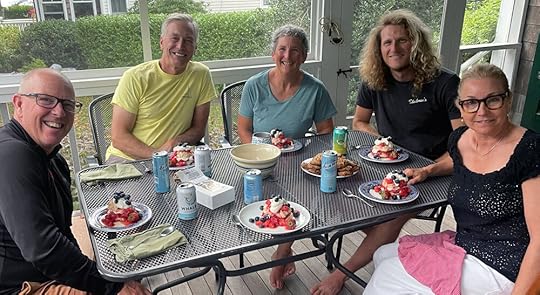
I did offer to create a fictitious recap of close-fought battles for a cash prize, but when I sat down to write I realized: I wouldn’t change a thing about our summer, even for entertainment purposes. Our reward was just showing up, Monday after Monday, to enjoy the in-person, in-the-moment camaraderie of regular local fleet racing. No cash prize could seem so worthwhile.
Many of us will travel to Snipe regattas over the winter, but I’m already looking forward to Monday nights in 2026; another chance to overlay our local theme of Controlling Our Own Destiny onto the international class motto of Serious Sailing, Serious Fun. We have a WhatsApp group, so send me an email if you’d like more information. And thanks to every single sailor who joined us; each of you helped make summer Mondays synonymous with Snipe sailing!
The post Controlling Our Fleet Destiny: 2025 Newport Snipe Sailing appeared first on Carol Newman Cronin.
September 4, 2025
Curiosity, Connections, and Witty Banter
Last week I wrote about my latest Seahorse profile, which was sparked by a trivia question (and the witty banter* that followed). Today I’m going to dig into that origin story—because it’s a great example of two truths I find fascinating: the small world of sailing, and the contagiousness of curiosity.
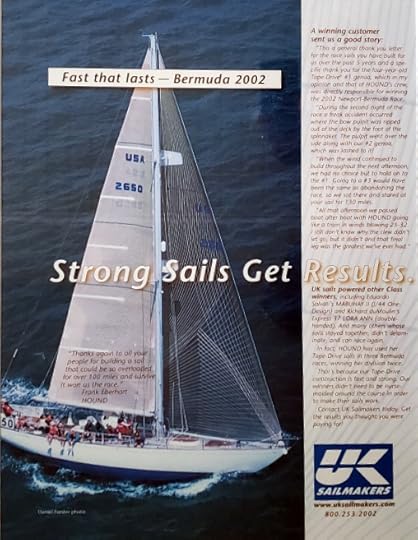 The Initial Query
The Initial QueryOur tale begins twenty-odd years ago, when UK Sailmakers ran a full-page magazine ad celebrating Hound’s 2002 Newport Bermuda Race class win. I really wanted to include the ad in The Heart of Hound as an important documentation of the boat’s history, but the picture I’d been sent (of a framed picture) was definitely not print-worthy. The only solution: track down a higher-resolution copy.
I had an old email address for Butch Ulmer; when that bounced back, I asked Rich du Moulin for help—and he responded within minutes, copying Butch’s current address. The next day there was a response from Butch himself that began with memories of Hound’s second owner:
“Frank and I had a long and happy relationship. He was the kind of customer that made the sail business a pleasure. A good seaman/sailor, you didn’t have to repeat things 5 times to get a point across. He was also a decisive gentleman. His usual answer was a “yes’ or a “no”.”
*(Later, in response to a friendly taunt from Rich, Butch stated: “the Gutenberg printing press hadn’t been invented when I started sailmaking.” Which is what inspired me to ask him for an interview.)
Bonus DiscoveryAdam Loory had also been copied on the email thread since (as Butch put it), “he likely produced the ad and would remember better than me.” Adam later sent me another Hound ad from 2014—one example of contagious curiosity.
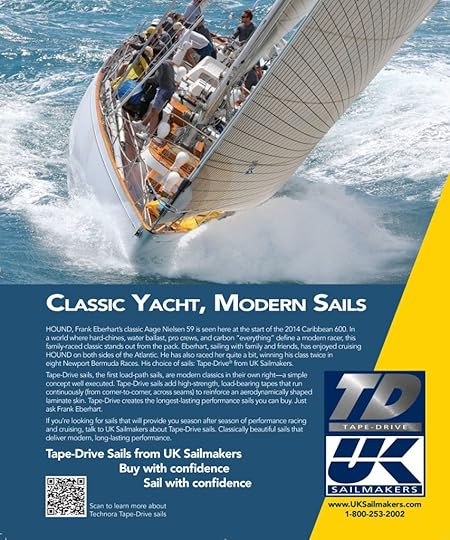 Where to Look Next
Where to Look NextButch didn’t know where I might find a better copy of the ad, but he did share a key piece of UK Sailmakers history: “The odds are that any ad was in SAIL Magazine.” So I sent off another email to SAIL’s editor, Wendy Clarke.
“As it turns out,” Wendy replied, “I just a few weeks ago went to Connecticut to gather the SAIL archive to keep it safe from dumpstering.” And even though I didn’t know exactly when the ad ran, she thought going back through back issues would be “a ton of fun.” (There’s a reason we get along so well.)
Sure enough, only a few days later she sent me a high-resolution copy of the ad. Wendy had enlisted the help of a mutual friend, and he’d found it almost immediately, deep in the January 2003 issue; perhaps a little of Hound’s fairy dust had led him to that page. It’s hard to imagine we SAIL readers ever had the attention spans to wade through such a word-heavy ad. . . but once The Heart of Hound is out in the world, it will be legible to all interested readers.
Wonderfully Interconnected WorldAs for the rest of the archives, Wendy says, “wow is there some wild stuff in there.” But she is no longer their guardian, thanks to the ongoing consolidation that has placed almost all US boating magazines under one company umbrella. I can only hope that future editors will keep SAIL’s archive intact—because we never know when we might need to go digging for a tiny piece of history.
Meanwhile, I’m grateful to both the wonderfully interconnected world of sailing and the contagiousness of curiosity! Got a similar small-world story, or even some witty banter about old age? Share it in the comments below, or send me an email; I read every single one, with gratitude.
Thanks for reading, and see you next Thursday.
The post Curiosity, Connections, and Witty Banter appeared first on Carol Newman Cronin.
August 28, 2025
Listening to the Legendary Butch Ulmer
Those of you who subscribe to Seahorse Magazine already know that there’s a profile of Butch Ulmer in their September issue. What you don’t know is what inspired my (very fun) interview with the Hall of Famer.
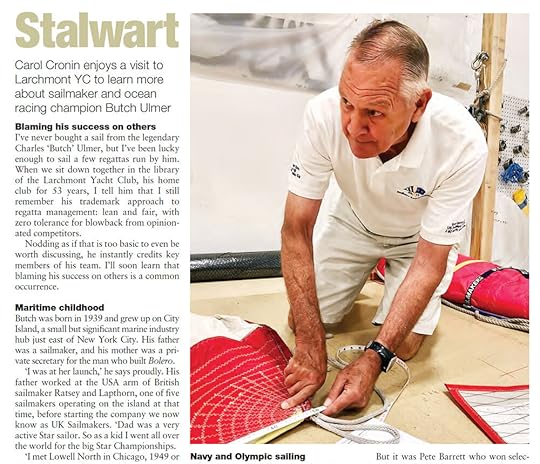
Butch is retired from both building sails and running regattas, and he sticks pretty close to home (Larchmont, New York), so we’re not likely to just run into each other. It was only when exchanging emails with him last spring, trying to track down yet another detail for the Hound book, that his witty banter inspired me ask: “Would you be willing to be my next victim for a Seahorse profile?”
“If you think I’d be a good subject for Seahorse Victimhood,” he responded, “I’d be happy to give it a try.” I offered to stop in on my way to Annapolis for a Snipe regatta, and a few weeks later we sat down in the elegant library of the Larchmont Yacht Club. After a chat that could’ve been much longer, I had more than enough detail to put together a profile.
Butch has already told his life story many times before, so the challenge was to dig out what Blue Robinson calls the “gold flakes” of detail that would make this interview fresh. For me, the key takeaway was that he tends to blame his own success on others—so I suggested that as a headline. (What can I say, it’s not my strong suit.) Instead, Seahorse (which is refreshingly unconcerned with SEO) chose a single word: Stalwart. Yup, that works too.
Not long after I received the printed copy, another email from Butch landed in my inbox: “You should work for the FBI or CIA because you catch even the smallest details. You treated me very kindly. Thank you!”
If you aren’t yet a subscriber to Seahorse, you can sign up for print (my recommendation) or digital—or both—on their subscribe page. They’ve graciously allowed me to share Butch’s profile here, and you can also read my previous profiles by following the links below.
Have a suggestion for a future profile? Share it in the comments below, or send me an email. I read every single one, with gratitude. Thanks for reading, and see you next Thursday.
Read Stalwart
Previous Seahorse ProfilesSeahorse Profile: Sharing a Brain
Paul Callahan: Maximizing His Unique Potential
Giving Paul Bieker Some Seahorse Love
Betsy Alison: Using All the Tools
Jerry Kirby: All the Stories are True
Peter Harken: What an Amazing Guy
Buddy Melges: He Really Was a Wizard
Toppa Talks: One Job, One (Big) Dream
Circus Minimus: The Rich Life of Bill Mattison
Mark Reynolds: Hard Chines and Unasked Questions
Dawn Riley: Setting the Standard
Clicks of Chance: Onne van der Wal
Just Say Yes: Stan and Sally Honey
Rod Davis: Why You Need His Wisdom in 2021
Rod Johnstone: An Amazing Legacy of Yacht Designs
A Final Conversation with Harry Anderson
Vince Brun Profile in Seahorse
The post Listening to the Legendary Butch Ulmer appeared first on Carol Newman Cronin.
August 21, 2025
“I Cheerfully Refuse” to Fulfill this Author’s Intention
Recently, while reading a 2024 novel by Leif Enger, I discovered a passing reference to another book I knew. That reminded me once again how, as authors, we never know what a reader will actually home in on—and it might well be something completely different than what we intended to emphasize.
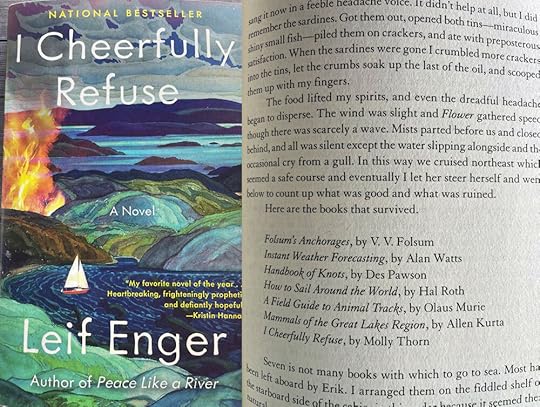
I Cheerfully Refuse is a dystopian novel with a surprisingly hopeful ending. The main character takes us on a rambling (and somewhat disjointed) tour around Lake Superior by sailboat, and when we first join him onboard (page 109) he lists the seven books that survived years of neglect by the previous owner. “Seven is not many books with which to go to sea,” the narrator reminds us, and the last item is probably what Enger considers most important: an unpublished novel that is so key to his story, he uses its title as his own.
But my own eyes stopped short well before that, when I recognized the third listing: Handbook of Knots by Des Pawson.
I have never met Mr. Pawson, but I’ve heard a lot about him and his book from his daughter Gael, a friend and former colleague. I knew the 2004 publication had attracted an audience well outside its UK home, but it still seemed like an incredible coincidence to find it listed as one of only seven books on a fictional Upper Peninsula sailboat. Is this true fame then? (Gael herself was not really surprised: “He gets everywhere!”)
Despite its refreshingly hopeful take on what might happen once society completely breaks down (and its wonderful title), I can’t wholeheartedly recommend I Cheerfully Refuse. Maybe it’s the dystopian way, but for me the story wandered too far off track to be truly gripping. I can, however, definitely recommend the surprises we sometimes find when we dive into books—especially when they are completely different from what the author really wants us to notice.
Have you ever found something unexpectedly familiar that distracts you from the author’s intent? Share it in the comments below, or send me an email; I really enjoy our discussions. Meanwhile thanks for being here, and see you next Thursday.
The post “I Cheerfully Refuse” to Fulfill this Author’s Intention appeared first on Carol Newman Cronin.
August 14, 2025
Navigating Nautical Muscle Memory
A few weeks ago, we took a three-day cruise on Katrina. Sailing to a familiar harbor in the Elizabeth Islands both brings back childhood memories and provides fresh conversational spark, so we never run out of things to talk about—especially since there are always more boat improvements to be considered.
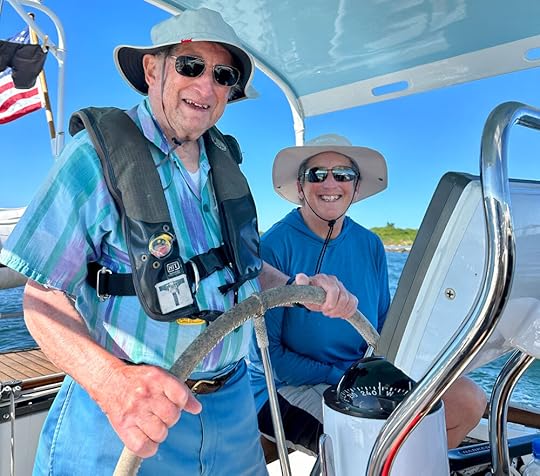 Under power last summer, with the old gearshift/winch handle in place (lower right).
Under power last summer, with the old gearshift/winch handle in place (lower right). The new engine is running great, but its newly located shift lever is definitely proving the strength of my muscle memory. Before, starting the engine began with grabbing a winch handle out of its canvas pocket (known privately as “Jerry’s pants”). That handle fit into the top of a stainless tube alongside the binnacle, and it was (usually) shifted into neutral before pushing the start button. When docking or anchor-digging, there was definitely a bit of feel required to successfully locate reverse; more so in recent years, as the transmission showed its age.
The new gearshift is a far more conventional shift lever mounted on the side of the binnacle. (I like to tease my dad that now anyone can steal the boat.) But that lever had always been used to engage the autopilot, which is now operated with a horizontal handle locked into that stainless tube . . . so the ergonomics have essentially been reversed. That means the new system requires two separate muscle memory adjustments.
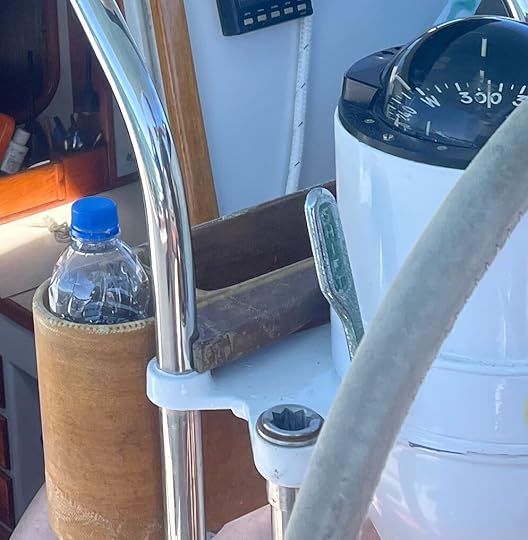 The old transmission slot now handles the autopilot, while the vertical shift lever controls engine forward and reverse.
The old transmission slot now handles the autopilot, while the vertical shift lever controls engine forward and reverse. While maneuvering in a tight harbor on our most recent cruise, Paul caught my dad trying to shift with what’s now the autopilot lever. No surprise that his muscle memory is even stronger than my own, since a majority of Katrina’s many miles have been completed with him at the helm.
I’m sure we will both get used to the new (and improved) shifting mechanics, but I’m equally sure our old habits will kick in and surprise us for many years to come. Meanwhile, I’m glad to be making more memories with both Dad and Paul—and very grateful for the many hours Dad has put into Katrina, providing a platform for both childhood memories and fresh conversations.
Got a muscle memory that needs to adapt? Share it in the comments below, or send me an email. I read every single one, with gratitude. See you next Thursday!
The post Navigating Nautical Muscle Memory appeared first on Carol Newman Cronin.
August 7, 2025
Removing Our Audio Filters (both Me and My Characters)
I’m sitting on top of a blueberry field overlooking a distant saltwater bay, in what seems like silence . . . until I recognize the distinct twitter of a scarlet tanager. Ah! She’s flown across the field, calling in now from stage right—worms with a friend, perhaps?
If I close my eyes, I also hear wind swishing through birches and the rustle of oak leaves (there is a difference). And the buzz of a hummingbird, pausing mid-air to stare in through the screen—as if I and my laptop are creatures in his personal zoo.
In the far distance, there is the occasional growl of a vehicle. Otherwise, the only sounds here are entirely un-manmade—a rare luxury in today’s noisy world. Back home, humans dominate my daily audio track: trucks jaking down a bridge, yard cleaners mowing and blowing and trimming. Plus the underlying coastal sounds of boat engines revving and halyards slapping against masts.
What do you hear, right now?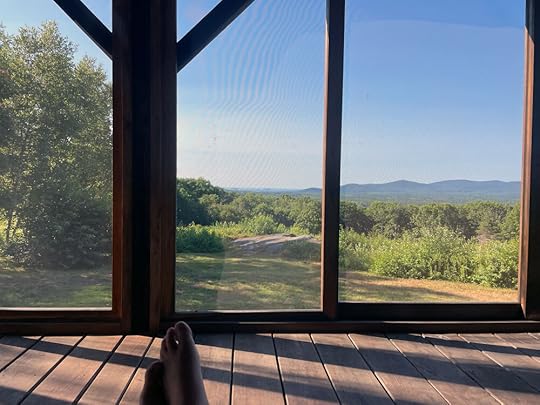
Stop reading for a moment, close your eyes, and focus on what’s coming in through your ears: voices, traffic, cell phone pinging away? Or maybe, if you’re lucky enough to be on vacation like me, waves lapping and seagulls cawing?
Our auditory senses can overwhelm us with information, so in self-defense we build up filters to screen out the “normal.” That’s one of the many challenges when describing what characters hear: giving readers enough detail to share the imagined experience, without over-emphasizing what that character would unconsciously filter out.
When we first arrive at this family cottage each year, I have to remember how to listen deeply again. Even if I lack the vocabulary to describe it (other than the distinctive scarlet tanager, I’m pretty much birdcall-oblivious), I still appreciate all the chirping and rustling—and the chance to let down my noise-cancelling audio guards for a few days.
Thanks for this chance to share the rich vibrance of “silence” with all of you . . . which might just form the future soundtrack of some imaginary island dweller. Maybe that character will pause to notice that a scarlet tanager has returned to her own nest, stage left. Or that the whisper of birch leaves is much more subtle than oak rustle. Or that the hovering buzz of a hummingbird inspection can make one feel like creatures in a zoo.
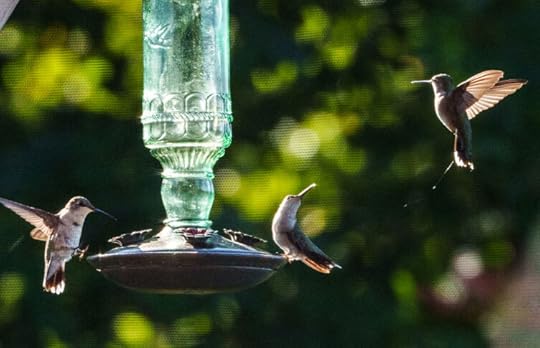 Even through a screen, Paul managed to capture the hummingbirds in action. (PaulCroninStudios)
Even through a screen, Paul managed to capture the hummingbirds in action. (PaulCroninStudios)When we really open our ears, silence can be the richest sound of all.
The post Removing Our Audio Filters (both Me and My Characters) appeared first on Carol Newman Cronin.
July 31, 2025
The Joys of (re)Joining the OPB Club
In my teens and 20s, I prided myself on an active membership in the OPB (Other People’s Boats) Club. Why, I wondered aloud to anyone who would listen, would I bother to own a boat when there were so many underutilized vessels available to borrow?
As a spunky teenager, I once called an owner (collect) to ask if I could take out his J/30 for an evening sail with a few friends. After what you might call a pregnant pause, he replied, “Well, if you’re asking, you’re probably qualified.” We had a lovely sail and returned his boat better than we found her.
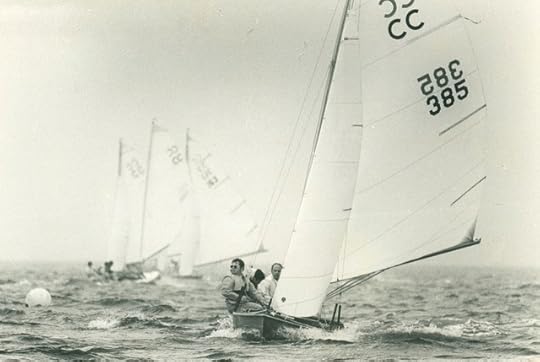
As a serious and loyal one design crew, I continued sailing other people’s boats well into my 30s. It was only once I took on an Olympic campaign that boat ownership (and maintenance) became a key part of my success.
Whether racing or cruising there is joy in ownership, which offers control of both the quality level and the schedule. And since logistics and boat tweaks are two of my strengths, I am a pretty good boat owner. But this year, no longer responsible for anything larger than a Snipe, I find myself circling back to the OPB club for summer cruising adventures.
By next summer, we will likely have welcomed another vessel into the family. For now, though, I’m going to revel in the chance to try out a variety of craft without the worries of launching, hauling, and keeping up the varnish to a certain standard: back to the flexibility of the OPB Club.
How about you: how is your boating season shaping up so far? Share your thoughts in the comments below, or send me an email. I read every single one, with gratitude. Happy high summer, and see you next week!
The post The Joys of (re)Joining the OPB Club appeared first on Carol Newman Cronin.
July 24, 2025
What Makes a Strong Opening Chapter?
Thanks to a recent house project, I’ve been thinking a lot about what books I like enough to shelve after reading. Their topics and genres range widely, but they all share a strong opening; one that somehow tickles my memory follicles, embedding the story in my brain long after I devour the last page.
Here are three very different examples, along with my thoughts about what works (or not) in their opening chapters.
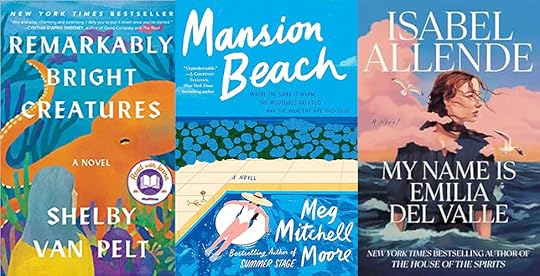 Remarkably Bright Creatures, by Shelby van Pelt
Remarkably Bright Creatures, by Shelby van PeltI read this book when it first came out in 2022 (here’s my review) and then reread it a few weeks ago for book group; once again, I found myself torn between devouring the story and marveling, “How did Pelt do that?”
It opens with an octopus explaining his plight: he’s captive in an aquarium tank that makes him long for open ocean. “I cannot remember, yet I can still taste the untamed currents of the cold open water.” He talks to us directly, adding that he will not hold our inadequate imaginations against us; “You are only human, after all.” He also sets up a unique ticking time bomb, citing the plaque on his tank that gives him only 160 days to live—because yes, he can both read and count.
What this opening achieves: The first chapter is only 500 words long. But thanks to its distinctive voice and implausible storyline, the story has already wrapped octopus arms around my brain.
What this opening fails to do: It doesn’t show us the larger context / world—which makes me hungry to learn what happens next.
Mansion Beach, by Meg Mitchell MooreI’ve been a MMM fan for years, fueled by her impressive book-a-year publishing pace. Her 2025 beach read (once again set on Block Island) starts off, strangely enough, with a prologued podcast transcript:
“Welcome to Life and Death on an Island, produced by All Ears Media. I’m your host, Milton Anderson, and on this podcast we’re taking taking a deep dive, so to speak, into life on a small island whose population increases nearly twentyfold from winter to summer.”
The episode interviews four members of the Town Council; “Some of these members believe a mysterious death last summer was related to issues of overdevelopment, landownership, and excessive lifestyles on the island.”
What this opening achieves: Sets up the book’s central question: who died? It also shows us the book’s future, while introducing us to multiple points of view; a precursor to the book itself.
What this opening fails to do: It doesn’t introduce us to the characters who actually tell the story, people we will quickly grow to care about (unlike the podcast’s talking heads).
My Name is Emilia del Valle, by Isabelle AllendeAllende opens her latest novel with a childhood memory from the sole point-of-view character:
“THE DAY I TURNED SEVEN YEARS OLD, APRIL 14, 1873, my mother, Molly Walsh, dressed me in my Sunday best and brought me to Union Square to have my portrait taken. The only existing photograph of my childhood depicts me standing beside a harp with the terrified expression of a man on the gallows, a result of the long minutes spent staring into the black box of the camera holding my breath, followed by the startle of the flashbulb. I should clarify that I do not know how to play any instrument; the harp was merely one of the dusty theatrical props crowded into the photography studio alongside cardboard columns, Chinese vases, and a stuffed horse.”
What this opening achieves: Unlike the previous two books, we start with the main character’s past, in what could be an unremarkable situation. But because it happens first, our reader-brains unconsciously give it weight—and that turns out to be a wise assumption. It also reveals a reporter’s wish for accuracy, thanks in part to four seemingly insignificant words; “I should clarify that . . .”
What this opening fails to do: We don’t know where this scared young girl will take us, though we do know it will take a lot of lyrical writing to get there.
These three very different books all begin with seemingly insignificant details that don’t quite satisfy—but all set up the book’s central question, which fuels our hunger to find out what happens next. Regardless of genre, the best openings trust the reader to make a few leaps of faith—a trigger for our memory follicles, which will help to embed the story in our brains long after we devour the last page.
Have you read something recently that you can’t stop thinking about? Share it in the comments below, or send me an email. I read every single one, with gratitude. See you next Thursday!
The post What Makes a Strong Opening Chapter? appeared first on Carol Newman Cronin.



